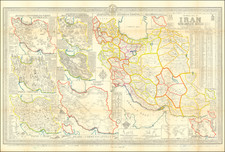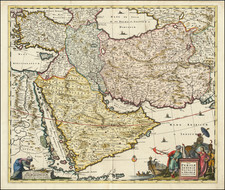17th Century view of the city of Soltaniyeh, 150 miles north-west of Tehran.
Soltaniyeh was built as the capital of Mongol Ilkhanid rulers of Iran in the 14th century. Its name which refers to the Islamic ruler title sultan translates loosely as "the Regal".
The view shows the mausoleum of Oljaitu, constructed in 1302–12, one of the outstanding examples of the achievements of Persian architecture and a key monument in the development of its Islamic architecture. The octagonal building is crowned with a 170 foot tall dome covered in turquoise-blue faience and surrounded by eight slender minarets. It is the earliest existing example of the double-shelled dome in Iran.
Jean Chardin
Jean Chardin (1643-1712) was a French merchant and traveler. In 1664, he set out for the East Indies with M. Raisin, a Lyon merchant. They traveled via Constantinople and the Black Sea, reaching Persia early in 1666. The same year the shah, Abbas II, made Chardin his agent for the purchase of jewels. In the middle of 1667, Chardin visited India and returned to Persia in 1669. The next year he returned in Paris, publishing an account of some events to which he was an eyewitness in Persia, entitled 'Le Couronnement de Soleiman Troisième,' in Paris, 1671. A learned nobleman, Mirza Sefi, a prisoner in his own palace at Isfahan, had entertained him, instructed him in the Persian language, and assisted him in this work.
Chardin again left for the East in August, 1671. He was in Constantinople from March to July 1672. A quarrel between the grand vizier and the French ambassador made it dangerous, forcing Chardin to escape in a small vessel across the Black Sea, where he travelled via Caffa, and through Georgia, and Armenia to Isfahan, which he reached in 1673. At Sapias, he was robbed by thugs in Samegrelo of all but two small bundles, worth £6,000. He stayed at Ispahan four years, following the court in all its removals, and making particular journeys throughout the land, from the Caspian to the Persian Gulf and the river Indus, and visiting several Indian cities. By these two journeys he earned a considerable fortune, and, deciding to return home, reached Europe in 1677 by a voyage round the Cape of Good Hope.
Chardin's subsequent account of his travels, his 10 volume "Voyages du chevalier Jean Chardin en Perse et autres lieux de l'Orient" (The Travels of Sir John Chardin) was published simultaneously in French and English in 1686. Chardin has been described as as one of the most important arbiters of European commercial and colonial expansion. His book went through numerous editions and by the time of his death in 1712 Chardin's chronicles of life and society in Persia had become one of the fundamental texts for this burgeoning field of study, and his meticulous accounts of the country earned him the praise of Gibbon, Montesquieu, and Voltaire.










![[Empire of Alexander The Great] Antiquor? Imperiorum Tabula in qua prae caeteris, Macendonia seu Alexandri Magni et Expeditiones exarantur . . .](https://storage.googleapis.com/raremaps/img/small/70608.jpg)
![Turquie d'Asie, Arabie, Perse, Caboul, Beloutchistan et Turkestan [Asia Minor, Arabia, Persia, Kabul, Baluchistan and Turkestan]](https://storage.googleapis.com/raremaps/img/small/94469.jpg)

![[Peninsula of Qatar shown] Map of Persia, Arabia, Turkey in Asia, Afghanistan, Beloochistan](https://storage.googleapis.com/raremaps/img/small/100289.jpg)
